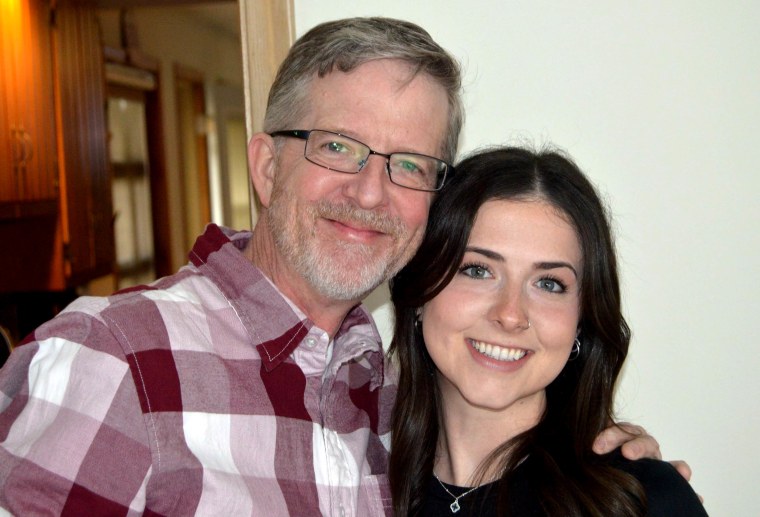At first, Aubrey Hasley thought she was having a migraine. As the room spun and she struggled to walk, she realized something worse was occurring.
In June last year, Aubrey Hasley, then 22, began experiencing “really loud” ringing in her ears.
“It was pretty hard to ignore. It scared me for a few seconds,” Hasley, now 23, of the Chicago area, tells TODAY.com. “I describe it as like when a microphone gets too close to the speaker and makes that vibration noise.”
Then she felt a migraine coming on, but it didn’t feel like what she’d experienced in the past. As her symptoms intensified she visited the emergency room, and Hasley eventually learned that she’d had a stroke.
“I was definitely very scared and really hoping and praying for the best,” she says.
Tinnitus, headache escalate to stroke signs
For most of her life, Hasley experienced migraines with auras several times a year. When the ringing in the ear, also known as tinnitus, first started, she thought it seemed odd, but it didn’t feel like a migraine. Then she felt an intense pain in her head.

“I was going to try to nap that (headache) off,” Hasley says. “When I went to bed, the red flags kept coming.”
Instead of having auras, Hasley felt “super dizzy” as the room spun around her. When she tried to move, she had little coordination between her upper body and legs, and her balance felt unsteady.
“I was home alone when things really started to feel off,” Hasley says. “I actually did end up sending my friends a text like, ‘I think I’m having a stroke.’”
Hasley had been working with stroke patients, making her more aware of the symptoms than many others might be. Even still, she “wasn’t super positive” that’s what was happening to her, she recalls.
Her brother called and she told him she wasn’t feeling well. Soon after, her family returned home, and her mom took her to the local emergency room.
“My brother helped carry me to the car because I was having so much trouble walking,” Hasley says. “At the ER, they started treating me for vertigo.”
The medications didn’t ease any of her symptoms, and Hasley began to worsen.
“I was speaking with my mom in the room, and she could tell that I started talking weird,” she says.
Doctors gave her a CT scan, which came back with normal results. But Hasley continued having symptoms.
“Things did start progressing. I had double visions, loss (of control) of the right side of my body,” she says. “My face was drooping. I had jaw numbness and slurred speech.”
These signs are characteristic of stroke, and doctors ordered another CT scan and MRI to understand what was happening.
“They started doing the stroke tests, where they had me try to read and identify images and move my hands and legs in a certain way,” she says. “They did confirm it was a stroke.”
Doctors thought clot-busting drugs might not be the most effective in treating Hasley’s stroke as so much time had passed since her symptoms began. They recommended a thrombectomy, a minimally invasive procedure that allows doctors to remove the clot from blood vessel it’s blocking.
“That was the better option,” she says.
Hasley remained awake during the procedure.
“My surgeon was actually talking me through what I might feel, when I might feel it,” she says. “It was pressure. That’s the best word I’ve used to describe it — no pain and it didn’t even last super long.”
Stroke can happen at any age
A stroke occurs when blood flow to the brain is blocked or there is bleeding in the brain. Most often stroke occurs in people 65 and older, but it can happen at earlier ages.
“We are seeing an increasing trend in young people, especially in females,” Dr. Mohammad Anadani, chief of neuroendovascular services at the Endeavor Health Neurosciences Institute in Arlington Heights, Illinois, tells TODAY.com. “Stroke can happen in any age.”
Anadani performed Hasley’s thrombectomy.

Knowing the signs of stroke can help people receive timely treatment. Symptoms, which spell out FAST, are:
- F: Facial weakness
- A: Arm or leg weakness
- S: Slurred speech
- T: Time—calling 911 immediately and receiving stroke treatment improves outcomes
While stroke in older people is often associated with risk factors including high blood pressure and Type 2 diabetes, risk factors in your people are “slightly different.” Risk factors for young people include:
- Family history of stroke
- Torn blood vessel
- Sickle cell disease
- Clotting disorder
- A congenital heart condition
Hasley had a congenital heart defect called a patent foramen ovale, or a hole in the upper chambers of her heart, which allowed a blood clot to travel to her brain and cause a stroke. During fetal development, everyone has a PFO, but in most people, the hole closes. People with PFOs rarely realize they have them because they’re often asymptomatic.
“Any patient who has stroke, they’re at risk of having another stroke,” Anadani says. “Repairing the PFO … reduces the risk of having stroke a lot. It doesn’t make it zero, but it does reduce it significantly.”
Even though most people who have stroke are older, Anadani feels it’s important to raise awareness of stroke in young people. If people have signs of stroke, they should seek help immediately and he hopes that physicians start recognizing it more in young people.
“Not only do patients not think of stroke at a young age, but also even physicians don’t think of stroke at a young age, and that leads to misdiagnosis that could have devastating consequences,” he says. “Stroke can happen at any age. Anytime you think it’s stroke, just call it a stroke until proven otherwise.”
On the ‘patient side’
As an occupational therapy graduate student, Hasley has been learning to treat stroke patients. Her experience changed her as a health care provider.
“It’s one thing to learn about it and try to carry out the empathy, but it’s really been another thing to be on the patient side and know what it’s like to go through something traumatic,” she says. “I want to be more of that encouraging, supportive person because it really helped me feel more comfortable and safe when I was going through that.”
Thanks to quick intervention, Hasley did not need to undergo any physical, speech or occupational rehabilitation to recover. In August 2024, Hasley underwent a procedure to have her PFO repaired. She’s noticed a change since then.
“An interesting thing is that I used to get migraines with auras a couple of times a year, and since having that surgery, I haven’t had one,” she says.
After physically recovering, she started her master’s program, and she will graduate in August 2026.
Sometimes, she still worries about her health.
“I found myself back in the ER because I was just very anxious,” she says. “A little bit of panic attack mode with headache or symptom I started feeling.”

Hasley hopes her story encourages others to learn the signs of stroke and seek medical help when they feel unwell. When she was having a stroke, she was initially “a little bit hesitant to go to the ER” because of her age, she recalls.
“I didn’t want to be dramatic and get there and them tell me it was just a migraine and send me home,” she says. “But we know our bodies, and it’s important to listen to that.”



